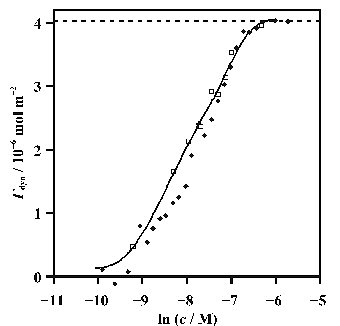Neutron Reflection
Techniques: Neutron Reflection
Neutron reflection (NR) can be used to measure directly the surface excess of aqueous surfactant monolayers, and has the chemical specificity to distinguish different components in mixed surfactant monolayers. The reflection of neutrons at an interface is formally identical to that of s-polarised light, and the refractive index of a substance for neutrons can be related to type and number of atoms in the surfactant. The scattering of hydrogen and deuterium have opposite signs, hence with the right ratio of pure water to heavy water the aqueous substrate can be made to be transparent to the incoming neutron beam.
In my research group we have applied neutron reflection in the study of surfactant adsorption on an overflowing cylinder. Reflectivity profiles of the neutrons are fitted to determine the surface excess of surfactant at the interface. The research is carried out at international facilities such as the Rutherford�Appleton Laboratory in Didcot, Oxfordshire. After a calibration experiment with pure D2O, measurements of the surface excess can be carried out typically in about 20�120 minutes.
In the figure below there the open squares are direct measurements made with NR of the surface excess of a cationic surfactant, CTAB, on an overflowing cylinder. Only a couple of measurements were made at low surface coverage because the signal is weak and hence the acquisition time is long. The curve represents a fit to over 30 values of the coefficient of ellipticity measured by ellipsometry. The measurements by neutron reflection were required to convert the ellipsometric data into a measure of the surface excess. The closed diamonds show data acquired by external reflection FTIR spectroscopy assuming a linear relationship between the surfactant peaks and the surface excess.

Advantages
- Neutron reflection can be used to give a direct quantification of the surface excess of surfactants at the air�water interface by fitting reflectivity profiles to determine the surface excess at the interface
- Structural information about the surfactant layer can be studied by the selective deuteration of parts of the surfactant chains
- The composition of mixed surfactant layers can be probed by the selective deuteration of one component
Drawbacks
- Quantification is severely limited a low surface coverage. Ellipsometry and external reflection FTIR spectroscopy have been used more effectively to determine the surface coverage of sub-monolayers after calibration with data from neutron reflection. Also, there are often discrepancies between the values of the surface excess determined with neutron reflection and those attainable by surface tension isotherms (the surface tension is related to the surface excess by the Gibbs equation).
- The technique is very expensive. Not only is the beamtime several thousand pounds per day, but the deuteration of surfactants is costly and time consuming.
